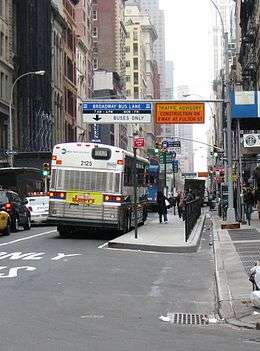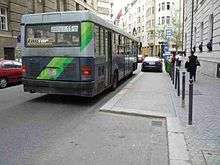Bus bulb



A bus bulb, also called a bus boarder, bus border or a bus cape,[1] is an arrangement by which a sidewalk or pavement is extended outwards for a bus stop; typically the bus bulb replaces roadway that would otherwise be part of a parking lane. With bus bulbs or boarders, a bus can stay in its traffic lane to discharge and pick up passengers, instead of having to pull over to the curb.
The term bus bulb is prevalent in North American usage, whilst bus boarder or bus border is used elsewhere.[2][3][4]
A bus bulb or boarder can be considered as a specific form of curb extension, although that term is more normally used to describe a sidewalk extension for the purposes of traffic calming or other traffic management purposes.
Benefits
Benefits include preventing buses from being delayed by having to pull back into traffic, reducing risk of traffic collisions, reducing pedestrian exposure in crosswalks (if provided at the same location), reducing sidewalk congestion, providing space for bus patron amenities including bus shelters, and traffic calming. The protrusion also facilitates easier full length alignment of a bus entrance with a raised kerb stop, especially to allow level boarding in the case of low-floor buses.[3]
Bus bulbs also retain more parking when compared to a bus stop located in a parking lane, as a bus stop so located requires run-in and run-out tapers. Together these tapers may take up as much space as the actual stop, requiring parking to be prohibited over a longer length of road than with a bulb, where cars can park immediately on either side of the bus stop itself.[3]
Drawbacks
The main drawback is for cyclists. The narrowing of the road can create danger for cyclists if the design does not take their needs into account.[3][5] Where more than one lane exists in one direction, modelling has shown that there is no additional delay overall for following drivers, since the buses have shorter dwell times (there is less time spent pulling back into traffic) and since following vehicles may use the second lane for passing.[2]
Tram/streetcar bulbs
Some tram or streetcar systems use similar bulbs, such as the Brussels tram network and the Toronto streetcar system. The latter, which operates mostly on traditional streetcar tracks in mixed traffic with cars, and has frequent request stops similar to bus routes, is introducing bulbs at some high-traffic stops and transfer points that have been recently renovated, notably on Roncesvalles Avenue. The first bulbs (called bumpouts locally) along Roncesvalles Avenue also accommodate cyclists as the bike lane running parallel to the streetcar tracks would gently rise up from the road level to run on top of the bumpout. When the streetcar is boarding, cyclists have to stop behind the yellow line to allow riders on and off.[6] There are three expected goals for these bulbs:
- Prevent vehicles from parking in front of streetcar stops.
- Increase standing room on the often restricted sidewalks at stop locations in some of the densest regions of the city.
- Improve safety for passengers boarding and alighting at these stops; unmodified stops require passengers to step into traffic to board/alight. The safety concerns are mostly with regard to drivers who are inexperienced at driving among streetcars in mixed traffic.
Streetcar bulbs may also be beneficial at higher-capacity stops along other streetcar routes, and may be rolled out in conjunction with longer streetcars on the route.
References
- ↑ "Principles of successful high quality public transport operation and development, Guidelines for European High Quality Public Transport in small and medium sized cities" (PDF). Directorate General for Energy and Transport, European Commission. 2009. pp. 83–85. Retrieved 2014-01-17.
- 1 2 "Transit Cooperative Research Program Report 65, Evaluation of Bus Bulbs" (PDF). Transportation Research Board. 2001. p. 1. Retrieved 2008-04-18.
- 1 2 3 4 "Accessible bus stop design guidance" (PDF). Transport for London. 2006. pp. 31–36. Retrieved 2008-04-18.
- ↑ "Buses". Auckland City Council. Retrieved 2008-04-18.
- ↑ "Transit Cooperative Research Program Report 65, Evaluation of Bus Bulbs" (PDF). Transportation Research Board. 2001. pp. 5–22. Retrieved 2008-04-18.
- ↑ These bulbs are also featured in the westbound of Johnston Road in Victoria City, Hong Kong Island. "Lanes, tracks and bikes". Roncesvalles Village BIA.
| Look up bus bulb in Wiktionary, the free dictionary. |